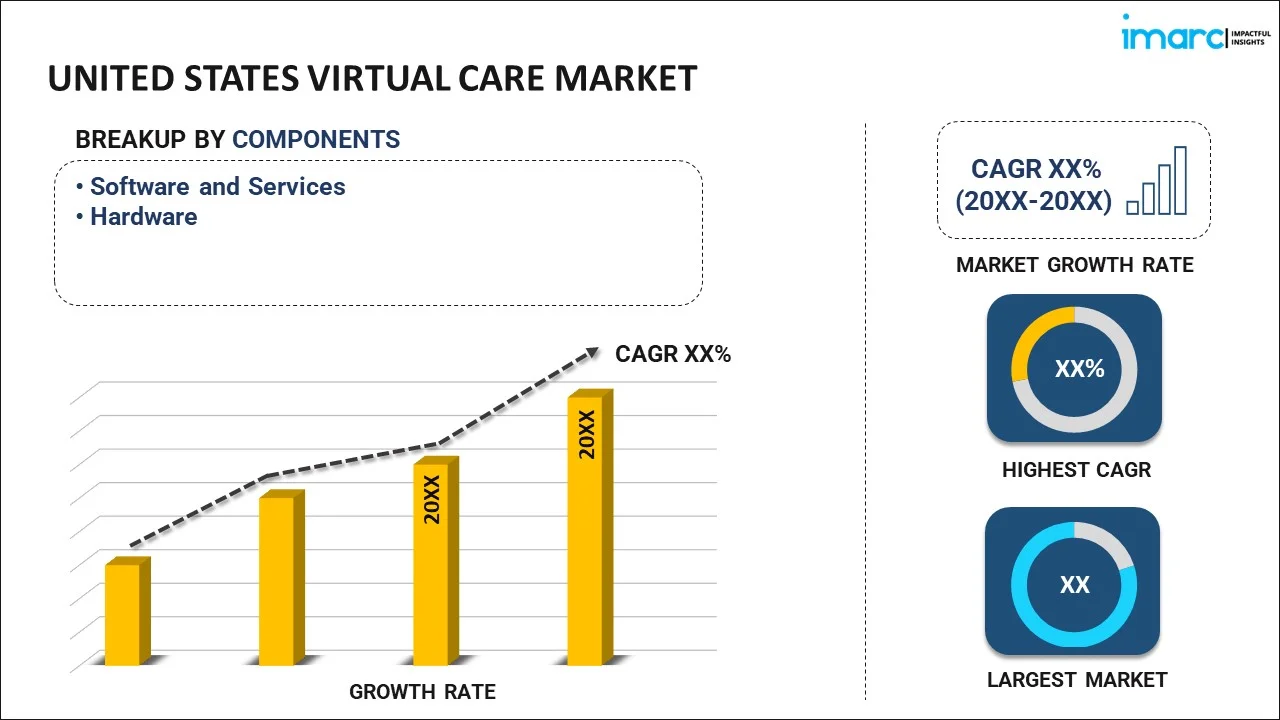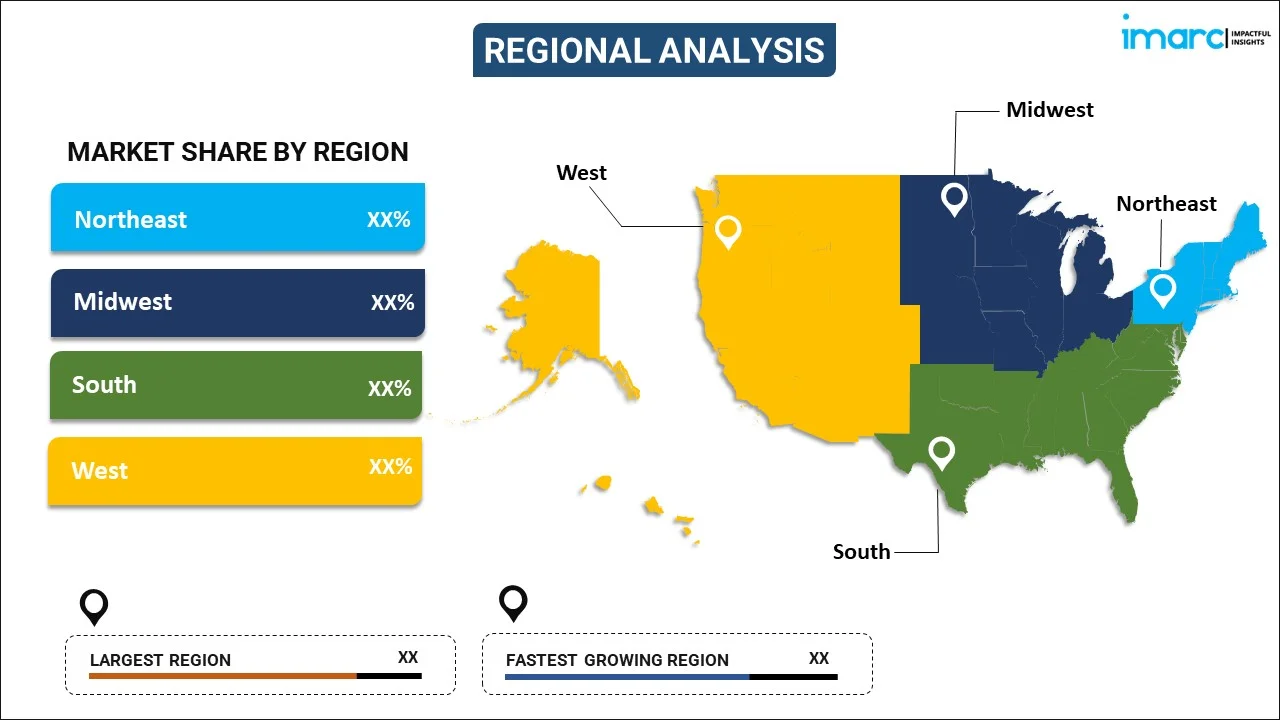
United States Virtual Care Market Report by Component (Software and Services, Hardware), Consultation Type (Video Consultation, Audio Consultation, Messaging, Kiosks), Application (Allergy and Immunology, Pediatrics, Family Medicine, Internal Medicine, Dermatology, Cardiology, and Others), End User (Hospital and Clinics, Pharmacies, and Others), and Region 2025-2033
Market Overview:
The United States virtual care market size is projected to exhibit a growth rate (CAGR) of 30.35% during 2025-2033. The widespread adoption of digital technologies, the Covid-19 pandemic-induced demand, emerging trends of value-based care, rising focus on mental health, and supportive regulatory changes, reshaping healthcare delivery represent some of the key factors driving the market.
|
Report Attribute
|
Key Statistics
|
|---|---|
|
Base Year
|
2024 |
|
Forecast Years
|
2025-2033
|
|
Historical Years
|
2019-2024
|
| Market Growth Rate (2025-2033) | 30.35% |
Virtual care, commonly known as telehealth or telemedicine, is a modern healthcare approach that employs digital communication technologies to provide medical services remotely. It involves the use of video calls, online chats, and mobile applications to facilitate consultations between healthcare professionals and patients, regardless of geographical distances. This method enables patients to access medical advice, diagnosis, treatment, and monitoring remotely, eliminating the need for physically visiting the healthcare facility. Virtual care encompasses a wide range of medical services, including primary care consultations, specialist appointments, mental health therapy, and prescription refills. It allows healthcare providers to assess patients' symptoms, offer medical advice, prescribe medications, and monitor chronic conditions through digital channels. Virtual care provides the benefits of improved access to medical services, reduced travel time and costs, increased patient engagement, and the potential for earlier intervention in health issues. As the digital landscape continues to evolve with continuous technological advancements, increased internet accessibility, and the need for convenient healthcare solutions, the virtual care industry is poised to play a pivotal role in shaping the future of healthcare delivery.
United States Virtual Care Market Trends:
The widespread adoption of digital technology and increased internet connectivity in the United States have paved the way for virtual care to become a feasible and accessible option for healthcare providers and patients, primarily driving the market growth. Besides this, the convenience offered by virtual consultations, allowing patients to receive medical counsel and treatment without the need for travel or physical presence, is creating a positive outlook for market expansion. Moreover, the COVID-19 pandemic influenced lockdowns, social distancing measures, and the strain on healthcare facilities in the country, which, in turn, led to a surge in demand for remote healthcare solutions, impelling a rapid product adaptation among medical providers and consumers. Currently, the rising emphasis on value-based care and outcomes-based reimbursement models has prompted healthcare systems to explore cost-effective ways of delivering quality care, such as virtual care, thereby propelling the market forward. In addition to this, the escalating consumer recognition regarding the importance of mental health is generating a surging need for accessible mental health services, leading to the integration of virtual mental health therapy platforms, which is strengthening the market growth. Besides this, virtual care allows individuals to seek therapy without the stigma sometimes associated with in-person visits, thus expanding access to mental health support and subsequent product adoption. Furthermore, favorable regulatory changes and policy updates by the federal and state governments of the United States to ease restrictions and promote the adoption of virtual care are presenting remunerative opportunities for market growth. Apart from this, the introduction of various telehealth reimbursement policies by public and private payers incentivizing healthcare providers to offer virtual care services, making it financially viable, is aiding in market expansion.
United States Virtual Care Market Segmentation:
IMARC Group provides an analysis of the key trends in each segment of the United States virtual care market report, along with forecasts at the country level for 2025-2033. Our report has categorized the market based on component, consultation type, application, and end user.
Component Insights:

- Software and Services
- Hardware
The report has provided a detailed breakup and analysis of the market based on the component. This includes software and services, and hardware.
Consultation Type Insights:
- Video Consultation
- Audio Consultation
- Messaging
- Kiosks
The report has provided a detailed breakup and analysis of the market based on the consultation type. This includes video consultation, audio consultation, messaging, and kiosks.
Application Insights:
- Allergy and Immunology
- Pediatrics
- Family Medicine
- Internal Medicine
- Dermatology
- Cardiology
- Others
A detailed breakup and analysis of the market based on the application has also been provided in the report. This includes allergy and immunology, pediatrics, family medicine, internal medicine, dermatology, cardiology, and others.
End User Insights:
- Hospital and Clinics
- Pharmacies
- Others
The report has provided a detailed breakup and analysis of the market based on the end user. This includes hospital and clinics, pharmacies, and others.
Regional Insights:

- Northeast
- Midwest
- South
- West
The report has also provided a comprehensive analysis of all the major regional markets, which include the Northeast, Midwest, South, and West.
Competitive Landscape:
The report has also provided a comprehensive analysis of the competitive landscape in the market. Competitive analysis such as market structure, key player positioning, top winning strategies, competitive dashboard, and company evaluation quadrant has been covered in the report. Also, detailed profiles of all major companies have been provided.
United States Virtual Care Market Report Scope:
| Report Features | Details |
|---|---|
| Base Year of the Analysis | 2024 |
| Historical Period | 2019-2024 |
| Forecast Period | 2025-2033 |
| Units | Billion USD |
| Scope of the Report | Exploration of Historical and Forecast Trends, Industry Catalysts and Challenges, Segment-Wise Historical and Predictive Market Assessment:
|
| Components Covered | Software and Services, Hardware |
| Consultation Types Covered | Video Consultation, Audio Consultation, Messaging, Kiosks |
| Applications Covered | Allergy and Immunology, Pediatrics, Family Medicine, Internal Medicine, Dermatology, Cardiology, Others |
| End Users Covered | Hospital and Clinics, Pharmacies, Others |
| Regions Covered | Northeast, Midwest, South, West |
| Customization Scope | 10% Free Customization |
| Post-Sale Analyst Support | 10-12 Weeks |
| Delivery Format | PDF and Excel through Email (We can also provide the editable version of the report in PPT/Word format on special request) |
Key Questions Answered in This Report:
- How has the United States virtual care market performed so far and how will it perform in the coming years?
- What has been the impact of COVID-19 on the United States virtual care market?
- What is the breakup of the United States virtual care market on the basis of component?
- What is the breakup of the United States virtual care market on the basis of consultation type?
- What is the breakup of the United States virtual care market on the basis of application?
- What is the breakup of the United States virtual care market on the basis of end user?
- What are the various stages in the value chain of the United States virtual care market?
- What are the key driving factors and challenges in the United States virtual care market?
- What is the structure of the United States virtual care market and who are the key players?
- What is the degree of competition in the United States virtual care market?
Key Benefits for Stakeholders:
- IMARC’s report offers a comprehensive quantitative analysis of various market segments, historical and current market trends, market forecasts, and dynamics of the United States virtual care market from 2019-2033.
- The research study provides the latest information on the market drivers, challenges, and opportunities in the United States virtual care market.
- Porter's five forces analysis assist stakeholders in assessing the impact of new entrants, competitive rivalry, supplier power, buyer power, and the threat of substitution. It helps stakeholders to analyze the level of competition within the United States virtual care industry and its attractiveness.
- Competitive landscape allows stakeholders to understand their competitive environment and provides an insight into the current positions of key players in the market.
Need more help?
- Speak to our experienced analysts for insights on the current market scenarios.
- Include additional segments and countries to customize the report as per your requirement.
- Gain an unparalleled competitive advantage in your domain by understanding how to utilize the report and positively impacting your operations and revenue.
- For further assistance, please connect with our analysts.
 Inquire Before Buying
Inquire Before Buying
 Speak to an Analyst
Speak to an Analyst
 Request Brochure
Request Brochure
 Request Customization
Request Customization




.webp)




.webp)












